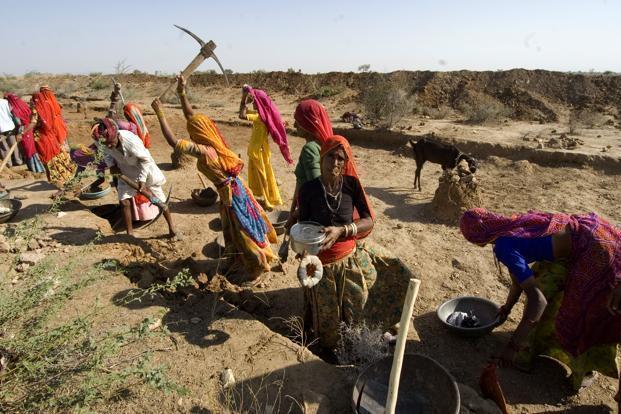Shunned by Cities, MGNREGA Comes to the Aid of Rural Bihar’s Migrant Workers

Image for representational use only.Image Courtesy : Livemint
Patna: Left with no other option – Satender Mandal, Mahesh Manjhi, Ram Lakhan Yadav and Deepak Kumar – migrant workers, who had arrived in Bihar from other states last month, are working as daily-wage labourers under the Mahatma Gandhi National Rural Employment Guarantee Act (MGNREGA) to earn their livelihoods.
Soon after their release from government-run quarantine centres, where they had been staying for the past 14 days after their return on Shramik Special trains, they have resumed work under MGNREGA.
They are four among lakhs of migrant workers who had returned to their native villages in Bihar after the lockdown began. According to top officials of the state government, nearly 30 lakh migrant workers had returned to Bihar from other states in the last one month due to the lockdown imposed to contain COVID-19. The first batch of stranded migrant workers arrived in Bihar on May 2.
“There is no work available in farms as Rabi season is over and the Kharif season begins in June, only after the monsoon. MGNREGA is the only easily available source of income. I am not alone; dozens of other migrant workers are working on different projects under MGNREGA for the last ten days,” said Satender Mandal, a resident of Simra panchayat in Jhanjharpur block in Madhubani district.
Mandal said that the question of earning a living did concern him after he returned home. “But I am lucky to have got work under MGNREGA. I am earning to survive for the time being. We will not starve,” the former factory worker in his mid-40’s, who had returned from Tamil Nadu, added.
However, Mandal expressed his unhappiness over the daily-wage rate of Rs 194 under MGNREGA, which is far less than the government’s own minimum wage for unskilled labourers.
For Mahesh Manjhi, a landless migrant worker, MGNREGA has provided him with a source of livelihood after he returned from Haryana in the first week of May. “If there was no MGNREGA, we would have starved to death because we had spent whatever little savings we had during the second phase of the lockdown,” said Manjhi, who belongs to the Musahar community, one of the most marginalised sections of society for centuries.
Manjhi, a resident of a small hamlet in Mohanpur block in Gaya district, said he was lucky that he was able to get work within his own panchayat.
Ram Lakhan Yadav, a resident of Mahua block in Vaishali district, was initially reluctant to work locally as a daily-wage labourer under MGNREGA. Yadav had returned from Surat in Gujarat, where he had been working as a helper in a factory which made saris. “There is no other work available elsewhere except under MGNREGA. I am working locally and plan on cultivating my small land holding this year,” he added.
MGNREGA appears to be the primary hope for sustaining livelihood in rural Bihar during the massive reverse migration which occurred due to the lockdown. Opportunities in other sectors like industries and other developmental projects are limited in the state. “MGNREGA has proven to be a big opportunity to provide work for migrant workers in rural areas. It is helping in job creation and creating a source of livelihood for the unskilled rural workforce, especially migrant workers,” said an official of the state’s Rural Development Department.
Arvind Kumar Choudhary, Principal Secretary of the Rural Development Department in Bihar, said the government’s aim is to create jobs in rural areas by taking up more projects under MGNREGA. “We are trying to provide work to job card holders in hundreds of different projects like digging ponds, renovation work of water bodies and the like under the state government’s ambitious Jal Jeevan Haryali mission and Pradhan Mantri Awas Yojana,” he added.
Choudhary claimed that work under MGNREGA is underway in more than 8,000 gram panchayats across the state.
According to officials of the department, about 4.62 lakh new job cards have been issued since April this year, of which 1.17 lakh job cards were issued to migrants at quarantine centres at the block level over the last three weeks.
In May, Chief Minister Nitish Kumar had demanded an increase in the number of work days under MGNREGA from 100 days to 200 days. The state government had sent a proposal to the Centre, requesting it to increase man-days (sharamik karya divas) from 18 crore to 24 crore in the current fiscal year 2020-21, to provide a source of livelihood to the poor, mostly migrant workers in rural Bihar.
The state has witnessed an increase in the number of people who have registered themselves as labourers under MGNREGA during the lockdown.
However, the Centre has not approved of the demand as yet. The plan to increase capacity is dependent approval from the Centre as MGNREGA is a central government sponsored scheme, an official said.
Bihar’s Rural Development Minister, Shrawan Kumar, said that till Wednesday, more than 15 lakh job card holders were given work daily under MGNREGA and that the department is planning on scaling the number up to 20 lakh people on a daily basis, soon. “Our focus is to provide livelihood to migrant workers,” he said.
Kumar said that there were a total number of 1.64 crore job card holders in the state with 54.69 lakh active workers.
There have also been reports of corruption in distribution of job cards to provide work to beneficiaries. Some complaints have also surfaced that MGNREGA work is being completed with machines instead of manual work.
Also, the already existing implementation of MGNREGA in Bihar is poor, if the government's own figures are anything to go by. As per official data, the average number of days of employment that MGNREGA provided for those in the state, including those who worked even for a day, was 41.94 days in 2019-20. During the financial year between 2018-19, the average number of days of employment provided was 42.19. The number in question was 36.36 days in 2017-18 and 37.37 days in 2016-17.
Only 20,000 households got 100 days of work courtesy the scheme out of 33.87 lakhs who had worked under it over the past year. About 24,573 out of 29.24 lakh households got 100 days of work during 2018-19, 15,556 out of 22,47 lakh in 2017-18 and the corresponding figure for 2016-17 was 14,165 of 22.86 lakh households.
MGNREGA was launched by the Congress-led United Progressive Alliance (UPA-I) government in 2005, to provide a minimum 100 days of employment out of 365 days in a year, to every rural household willing to do unskilled manual work.
As of Wednesday, Bihar had 4,155 confirmed cases of COVID-19 with 24 reported deaths.
Get the latest reports & analysis with people's perspective on Protests, movements & deep analytical videos, discussions of the current affairs in your Telegram app. Subscribe to NewsClick's Telegram channel & get Real-Time updates on stories, as they get published on our website.






















